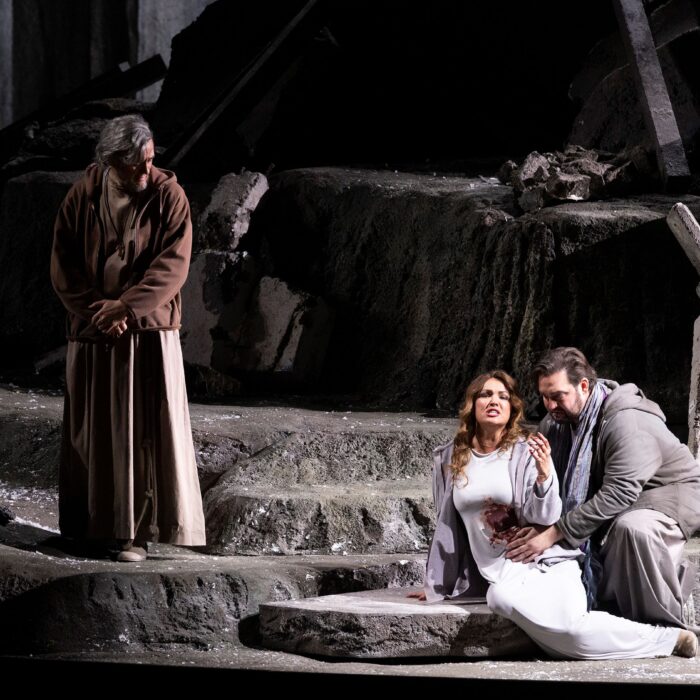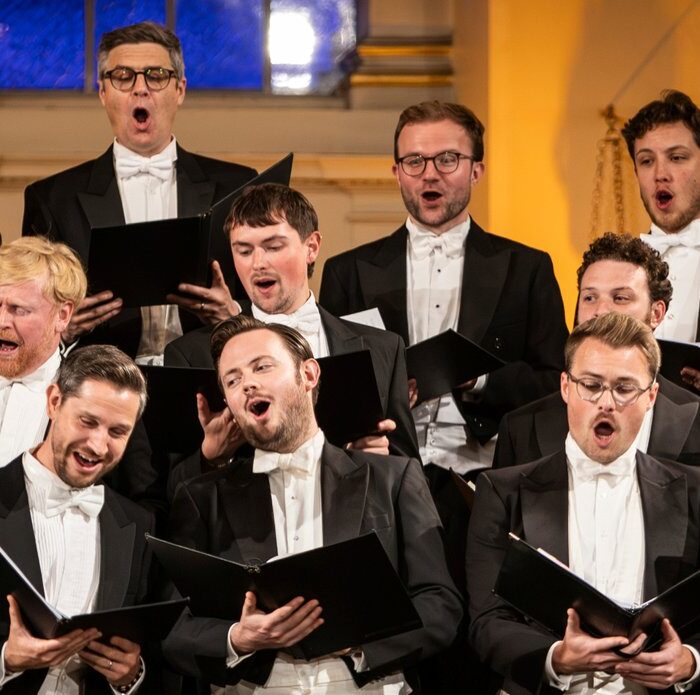
Janáček Brno Festival 2024 Review: Jenůfa
Veronika Kos Lulová Heavy-Handed Direction Undermined an Insightful Interpretation
By Alan Neilson(Photo: Marek Olbrzymek)
“Every stage work takes on new meanings with each new interpretation.” So reads the opening line of the program notes by dramaturg Marta Ljubková, writing about Janáček Brno Festival’s production of “Jenůfa.” She was being somewhat disingenuous. What was presented was not a change in emphasis or an exploration of hidden themes; rather, it was a heavy-handed intervention that included a new ending, new text, and, unbelievably, new music, provided by the band VIAH, a pop duo on electric keyboards, who pumped out a sound that was totally at odds with Janáček’s music.
Loulova’s Provocative Direction
As the audience filed into the auditorium for the beginning of the performance, it was met with an image of artist Jamie McCartney’s “The Great Wall of Vulva,” consisting of 20 casts of female genitalia. The original work consists of 400 vulvas; its aim is to “shed light on variety, diversity and the absence of a norm” and to draw attention to the pressures women are put under to have aesthetic plastic surgery. It was the opening salvo of a production, directed by Veronika Kos Loulová, that reinterpreted “Jenůfa” from a woman’s perspective in the 21st century, focused on the psychological difficulties experienced by women during childbirth and the early stages of motherhood.
Without a doubt, it is an interpretation with potential. Jenůfa has been placed in a high-stress situation, the subject of male violence and irresponsibility at the hands of Laca and Števa. She is pregnant, and the father, Števa, has abandoned her, and she is now fearful of the judgement that will be passed by the village community for having an illegitimate baby. She lives alone with Kostelnička, her stepmother, and the two try desperately to cope, not just with caring for the newborn baby but also having to keep it secret from a close-knit community. Little surprise, therefore, that Jenůfa falls into a pit of despair, aggravating any predisposition for postpartum depression, a condition that can also affect surrogates, such as the Kostelnička, who finds herself looking after both Jenůfa and the baby.
It started well. Loulová moved the drama to a contemporary setting, for which the scenographer and costume designer, Irina Moscu, created a cluttered modern-day apartment, where Jenůfa and the Kostelnička lived. The grandmother busied herself with household chores, while Stárek, the mill foreman, and obviously a regular visitor, sat comfortably reading a newspaper at the table and seemed very much at home. Laca had free rein of the house and moved around as if he lived there and did what he liked, as did Števa. The relationships were thus clearly established as close-knit, suffocating and overbearing, which Loulová amplified by accentuating the negative characteristics of the male figures, especially those of Laca and Števa. Laca, in particular, expressed no sign of love towards Jenůfa; rather, he was boorish, crude and cruel, always flashing his knife in front of her, sometimes with her panties twirling on its blade.
By the end of the first act, Loulová had successfully created an oppressive, threatening atmosphere based on intolerance and violence and clearly established Jenůfa’s vulnerability. There were, however, numerous irritations in her presentation, not least the interpolation of amplified texts of reviews from Preissova’s original stage play on which “Jenůfa” was based and quotations from members of ‘A Mother’s Smile,’ a group set up to care for women who have experienced psychological difficulties during pregnancy. They added nothing at all to the drama and brought the momentum to a complete stop. Also, the removal of all folk elements, while understandable given its contemporary setting, undermined the sense of community and therefore the outside pressures exerted on Jenůfa and the Kostelnička. The folk dances, therefore, also had to be jettisoned, which were replaced by an uncoordinated free-for-all that looked ugly and minimized the impact of the musical contrasts. There were other minor annoyances, but dramatically it worked fairly well.
Act two progressed in a similar vein. The characters were sensitively handled and successfully presented, capturing both Jenůfa’s and the Kostelnička’s emotional and psychological deterioration under the stresses of the situation. While the Kostelnička’s anxieties and emotions became more haphazard, Jenůfa looked oblivious to what was happening around her; she looked hollow and exhausted, clearly overwhelmed and unable to cope. Although it was a well-presented act, it was again subject to distracting interventions, this time with an amplified voice listing issues and products relating to new mothers, such as nipple cream.
Act three took the staging in a different direction. The apartment was melded with a wooded glade, into what appeared to be a dreamscape, with its meaning open to interpretation. Was it a projection of Jenůfa’s or the Kostelnička’s mind? Maybe it was a desire for a better world? Could it have been a representation of the heaven in which her murdered child now resides? Was it a contrast to the hell of a life lived in the apartment? Or was it something completely different? It did not really matter; it proved to be a successful device for encouraging the audience to think about the implications of such possibilities, and as such it was successful.
Unwelcome Alterations to the Opera
Unfortunately, the final duet between Laca and Jenůfa was cut, so that the opera ended with Jenůfa forgiving the Kostelnička, who was surrounded by other women in a show of solidarity. This went beyond Janáček’s intentions and felt wholly contrived. It also drew attention away from the legitimate portrayal of Jenůfa, the Kostelnička and women in general who suffer from male abuse, neglect or lack of understanding, as well as the problem of postpartum depression, which was supposed to be the main focus of Loulová’s interpretation and instead highlighted the fact that there was not a single male character with even a modicum of decency or empathy for Jenůfa’s or the Kostelnička’s conditions. For all his faults, Laca in the end accepts his responsibilities; this excised from the text as it went against the message. Even Stárek was allowed to sit through Jenůfa’s suffering while being tormented by Laca, just so that he could be shown to be a passive, disinterested male. It verged on propaganda, rather than a nuanced consideration of the problem.
Yet although Loulová’s staging was provocative, at times heavy-handed and occasionally irritating, her sure directorial grasp enabled her to fashion a reasonably successful interpretation in which her determination to insert her concerns about postpartum depression was made alongside, although not always within, what was a well-crafted drama. It was, therefore, a pity that she threw it all away by replacing the final duet with a nondescript piece of music by VIAH. It destroyed the effect that she had struggled to create, so that one left the theatre with a wholly negative impression.
A Raw, Exciting Orchestral Reading
The relatively small orchestral force of the Moravian Theatre under the baton of Anna Novotná Pešková created a dramatically stark and compelling reading. Its lean, transparent textures, in which the percussion often thrust itself into the foreground, gave the sound a rawness that sat well with Loulová’s staging, which was accentuated by the lack of warmth from the relatively small string section. Pešková was always sensitive to the drama’s twists and turns, complementing them with pleasing dynamic contrasts and changes in pace, and the melodies were crisply and deftly executed.
The star of the show was undoubtedly soprano Eliška Gattringerová, who essayed the role of the Kostelnička, although it was not the usual portrayal one might have expected. In line with Loulová’s interpretation, she became a sympathetic character, rather than a hard-headed matriarch, equally concerned about her own reputation as that of Jenůfa’s. Such was her success in presenting the Kostelnička as a well-intentioned, fundamentally decent woman who was unable to deal with the situation that it appeared completely natural that she should be forgiven by Jenůfa for the murder of her baby. Her singing performance was also wonderfully expressive, in which she captured the anxieties, stresses and fears that led the Kostelnička into committing such a horrendous crime.
Jenůfa was played by mezzo-soprano Barbora Perná, who produced an excellent acting performance that captured her mental state perfectly along with all its emotional contradictions. In Act one, she accepted and rebelled against Laca’s aggression, displayed her love for the unworthy Števa, and her contempt for Laca. In Act two, she had collapsed into an exhausted shell of herself. Yet underlying it all, she exuded a sense of decency and love. Her vocal performance was solid rather than exciting or revealing. Her singing was clear and articulate, and she expressed herself forcefully and passionately, but she lacked the frisson, the ability to add nuance and push the voice to the extremes that is necessary to dominate the role.
Tenor Josef Moravec was essentially only required to portray Laca’s negative characteristics and to steer clear of anything that might put him in a positive light, and he did it very well; he was frustrated, angry and resentful and simmered with a violence that was ready to explode. Possessing a resonant voice, which at times he could have used with more dynamic subtlety, he was able to intimidate Jenůfa and dominate a scene, as he forcefully pushed his voice into a confrontation.
Tenor Raman Hasymau has an agile voice with a pleasing timbre, although it can sound a little thin in the upper register, which he used impressively to capture Števa’s superficial character. Yes, he was pushed into emotionally uncomfortable situations, but he always managed to coat his voice with a veneer of insincerity or immaturity, which fitted perfectly with the tenor of the production.
Mezzo-soprano Sylva Čmugrová gave a clearly defined portrait of Grandmother Buryjovka, making it quite clear that she had no interest in Laca whatsoever.
Bass Jiri Pribyl had only the occasional line to sing as Stárek but was present for a large part of the first act, in which he successfully ignored Laca’s brutish behavior as if it were completely normal.
Sopranos Katerina Popová and Anna Moriová were parted as Karolka and Barena, respectively. Both delivered well-sung performances in what were small roles.
Final Thoughts
Personally, I found Loulová’s interpretation to be far too heavy-handed to consider it a success. Lecturing or berating audiences is never a good thing; they are quite capable of understanding a well-managed interpretation without having it spelt out in bold terms or using gimmicks, like having a pop duo bring the opera to a conclusion. It comes across as extremely patronising.
Actually, I had no problem with Loulová’s overall reading of the piece; in fact, I found it insightful. There is a very good “Jenůfa” contained within this production, but it is struggling to get out; a more nuanced approach is needed, one shorn of the extraneous additions that undermined all that is good about it.
It is co-produced with the Moravian Theatre Olomouc.



